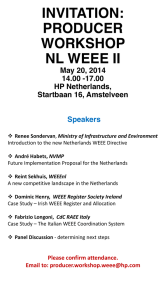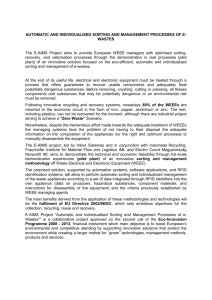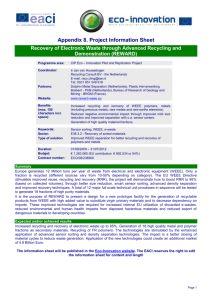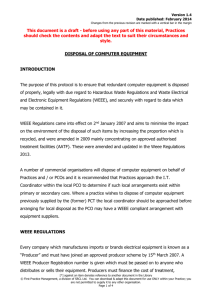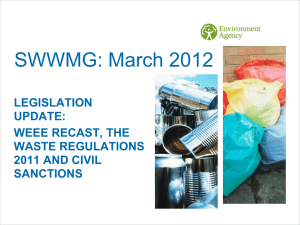Modelling and developing a WEEE collection network in the Oulu
advertisement
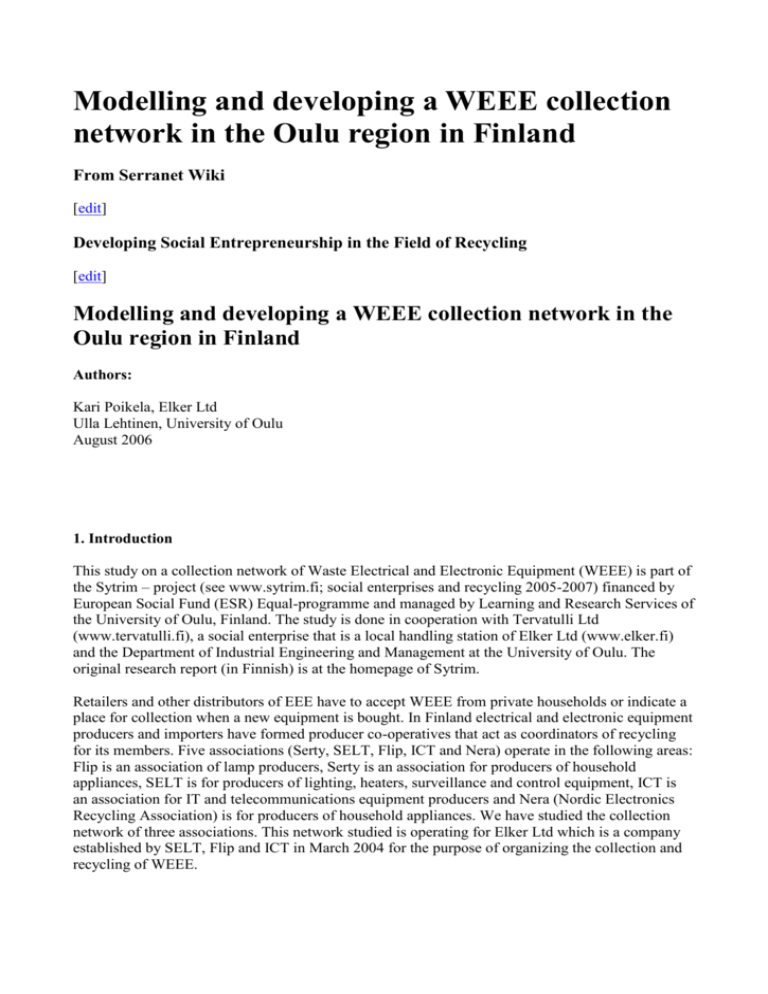
Modelling and developing a WEEE collection network in the Oulu region in Finland From Serranet Wiki [edit] Developing Social Entrepreneurship in the Field of Recycling [edit] Modelling and developing a WEEE collection network in the Oulu region in Finland Authors: Kari Poikela, Elker Ltd Ulla Lehtinen, University of Oulu August 2006 1. Introduction This study on a collection network of Waste Electrical and Electronic Equipment (WEEE) is part of the Sytrim – project (see www.sytrim.fi; social enterprises and recycling 2005-2007) financed by European Social Fund (ESR) Equal-programme and managed by Learning and Research Services of the University of Oulu, Finland. The study is done in cooperation with Tervatulli Ltd (www.tervatulli.fi), a social enterprise that is a local handling station of Elker Ltd (www.elker.fi) and the Department of Industrial Engineering and Management at the University of Oulu. The original research report (in Finnish) is at the homepage of Sytrim. Retailers and other distributors of EEE have to accept WEEE from private households or indicate a place for collection when a new equipment is bought. In Finland electrical and electronic equipment producers and importers have formed producer co-operatives that act as coordinators of recycling for its members. Five associations (Serty, SELT, Flip, ICT and Nera) operate in the following areas: Flip is an association of lamp producers, Serty is an association for producers of household appliances, SELT is for producers of lighting, heaters, surveillance and control equipment, ICT is an association for IT and telecommunications equipment producers and Nera (Nordic Electronics Recycling Association) is for producers of household appliances. We have studied the collection network of three associations. This network studied is operating for Elker Ltd which is a company established by SELT, Flip and ICT in March 2004 for the purpose of organizing the collection and recycling of WEEE. Because there has been overlapping between the stages of the collection process and the parties involved in the collection network causing ineffectiveness and high costs, the SYTRIM –project decided to include this study in its programme. Kari Poikela carried out the study between 15.12. 2005 – 28.2.2006. First, the present stage of WEEE collection was studied by identifying the best practices, problems, bottlenecks, volume and waste as defined in the lean concept . The material and information flows between the actors of the collection network were mapped out. Interviews were held with the main actors. The questionnaire presented in appendix 1 was used in the interviews. The aim of the case study was, firstly, to describe the present WEEE collection concept in the Oulu region. By mapping the collection network we were able to identify the problems and overlaps. Secondly, a new, more efficient model was introduced, and proposals for the future are made. 2. The implementation of the WEEE Directive in Finland For the national implementation of the WEEE directive, several degrees options exist which means different structural alternatives for the reorganisation of the treatment system are possible. In Finland the new legislation came into force in 13.8.2005, when the collection points had also to be set up. Pirkanmaa Regional Environment Centre was nominated as the responsible implementation authority for Finland. Finland’s legislation on waste provides that producers of electrical and electronic equipment shall organise the recycling and waste disposal of waste ensuing from products that they have brought to the markets and shall be responsible for the costs incurred. The producer must ensure that by 31 December 2006 an annual collection rate averaging at least four kilograms of waste electrical and electronic equipment per inhabitant from private households is achieved (Government Decree on Waste Electrical and Electronic Equipment 852/2004 ). Furthermore, producers shall: -organize a separate collection of all waste electrical and electronic equipment that can be collected, irrespective of whether the collection target has been achieved; -organize the delivery of separately collected waste EEE to an authorized treatment facility unless the appliances can be reused as a whole. Waste electrical and electronic equipment shall be collected and stored in such a way that appliances and components thereof that are suitable for reuse and recycling can primarily be reused or, as a secondary alternative, recycled as well as possible; -organize the treatment of separately collected WEEE at a facility that has an environmental permit. In making agreements with treatment facilities, producers shall give first priority to facilities that have introduced an environmental management system certified within the European Community; -ensure that any EEE that they put on the market after 13 August 2005 is labelled with the mark for separate collection; -ensure that any electrical and electronic equipment that they put on the market after 13 August is labelled with the mark that indicate the names of the equipment producer that brought the equipment marking must also indicate that it was put on the market after the enforcement of this Degree; -producers shall see to the provision of information and advice about the collection and recovery of WEEE. In the information given, particular attention shall be paid to ensuring that users of EEE in private households receive details about the obligation regarding separate collection, and instruction for collection systems and facilities available; -producers or treatment facilities acting on a producer’s behalf or another third party shall, by the end of April each year, inform the Pirkanmaa Environment Centre annually of products introduced to the markets and estimate the accumulated tonnage of WEEE, and the quantity of collected WEEE and quantity in tonnes and if possible, the number of items reused, separately recycled and otherwise recovered waste equipment; -submit an application to the Pirkanmaa Regional Environment Centre for registration in the producer data base and enclose information on the collection station network and agreements related to arrangements for waste disposal; -give sufficient security for equipment used in households to the Pirkanmaa Regional Environment Centre, for example, recycling insurance or a blocked blank account to ensure the fulfilment of waste disposal obligations. The Pirkanmaa Regional Environment Centre has stated that collection points should separate reusable equipment. The reusable equipment should be both suitable for reuse from both a financial and technical aspect i.e. there should be markets for used equipment. There should not be any harmful materials in those reusable equipment. The Finnish Decree also states that every consumer should have a reasonable opportunity of returning WEEE. This means that collection should be available in every rural municipality to some extent. One solution proposed for producers is that they could source semi-mobile collection services. A semi-mobile collection means that a retailer or local collection point have small collection points, which collection trucks empty on a regular basis. The producer co-operatives source logistics services from regional operators; usually from social enterprises or public institutions. As mentioned earlier, a private user or household can bring products to a collection point free of charge. So far, there are about 180 collection points that are mostly provided by the municipalities and, in some cases, private companies or social enterprises. On the other hand, non-private users, such as industry and offices, are not allowed to return WEEE to collection points and they are also charged. They should agree with the regional operator about the collection or return the WEEE to sorting stations. The regional handling of WEEE includes the sorting of EEE into re-usable and non-reusable ones. Also WEEE is divided into different product categories. At the pre-treatment stage the reusable appliances, spare parts and those materials that have reuse value are disassembled, stocked and delivered onwards. Figure 1, shows the main steps of reverse supply chain of WEEE in Finland. Figure 1. The stages of reverse supply chain of WEEE in Finland 3. The current stage of collection network in Oulu region The current stage of the collection network was studied between 27.12.2005-26.1.2006. Six collection points, two sorting points, and two handling stations were included in the study. The current stage of the collection network studied is presented in Figure 2. Collection points in rural districts There are in total 13 collection points in the area situated within a 100 kilometre radius of Oulu. Local municipalities maintained these points and each municipality has its own collection point. The whole system is managed by Oulu Municipal Waste Management Company providing containers to the collection points and taking care of transportation. At collection points the returned equipments are put into containers or cages without any sorting. The equipment collected by Elker Ltd is usually put into cages as per Figure 3. Only lamps are stocked separately. The amount of WEEE brought to these collection points varies greatly; the containers are filled up from one week to four weeks. When a container is full the personnel from the collection point orders the transportation. It is highly recommended that the return of WEEE is documented and signed by the user. In the collection point an acknowledgement receipt is provided (see table 2). In practice, the documentation is often forgotten and users return their equipment without guidance. The transportation from collection points to a sorting station situated in Oulu is done once a month or when ordered. The main problem observed was that the cages were heavy and there was a lack of proper equipment (forklifts etc) to handle the cages. Therefore, loading and unloading took a long time. Additionally, the wrong handling and improper storage facilities, especially in wintertime, easily damage returned reusable units and also open the possibility of theft. On occasions, the workers have given away working equipment that legally belongs to the producer co-operative. Figure 2. The present model of the WEEE collection network in Oulu region Figure 3. Cages at a collection point Sorting points From the collection points, the WEEE is transported to the premises of the Municipal Waste Management Company, which also operates as a local collection point. In the premises of the Waste Management Company WEEE is separated for different product co-operatives. A private company maintains the other sorting point, presented in the Figure 2. Companies can bring fluorescent tubes to a sorting station, which they are then delivered further with other hazardous waste. In figure 4, tubes are collected in a frame; although this is a difficult system to handle by one person. Figure 4. Collected tubes Pre-treatment station Tervatulli Ltd is a social enterprise situated in Oulu that reprocesses electrical and electronic equipment and the materials that are generated by disassembling and sorting. Tervatulli Ltd picks up Elker’s WEEE from sorting points in its own truck. In the pre-treatment station the WEEE is sorted into 17 different product categories; the main categories are IT- and telecommunications equipment (class 1 and 2) and equipment with cathode-ray tubes. The reusable equipment and components are separated (see figure 5) The WEEE is stocked in a pre-treatment station until it is delivered to treatments plants or disposed of. Information about the weight of numbered of cages is sent to the Oulu Municipal Waste Management Company and Elker Ltd which pass this information on to Pirkanmaa Environment Centre. Figure 5. Pre-treatment in Tervatulli Ltd. Some special features in the collecting system The producer co-operatives and local operators are looking for the most economical practices to organise the collection. The main challenges of WEEE collection rise from the contradictions in the legislation and the benefits for the producers. One contradiction affecting collection is the reuse value of EEE. For example, refrigerators have a negative value because they have few valuable components, but high transportation costs. On the other hand, circuit boards have a positive value because they contain many valuable materials. Thus, the transportation and handling stages of low reuse value categories of WEEE should be minimised. Earlier, waste and recyclable equipment were left in open containers or refuse dumps so that people were able to pick up the waste they needed. Now it is difficult to explain why it is illegal to pick up WEEE from containers belonging to producer’s associations. In order to avoid theft, the containers must always be locked. The study shows that the information and guidance in collection points were inadequate. In many cases consumers (i.e. users) are putting the returned equipment themselves into containers which results in containers not being filled properly or equipment being left outside. According to Elker’s instructions the user should also signed permission if he gives up working equipment for reuse purposes. The legislation highlights that a private consumer or household is able to leave WEEE without charge. On the other hand, companies, industry in general, and communities have to for pay WEEE collection. During this study, the computers brought to a pre-treatment station were randomly checked. It was found out that many computers were stripped-down e.g. valuable components had already been removed, which is quite common in business sectors. It seems be possible that companies use free of charge channels and are not yet familiar with the legislation. 4. The new model A proposal for a new model for collection network is presented in Figure 6. In this model the nonvalue added stages are removed. The main difference in the material flow is that the first sorting is done already at the collection point from where the material goes directly to the pre-treatment station. In addition, reusable or repairable equipment should be marked and handled differently in sorting stations. It was evident that packages and handling systems should be designed to better fit the different categories of WEEE. Moreover the current cages are very heavy between 400-700 kg and more than one person is needed to lift them. For example, sorted WEEE should be kept in roller cages instead of containers. General guidelines for the collection process are needed. Instructions are especially needed. The employees at sorting stations in general have low education and they need advice and education concerning the legislation and documentation. The documentation of returned WEEE is currently done manually. In future, a common electronic system should be introduced into all the stages of the collection chain. A web-based system would considerable help reporting and production control in the collection process. Figure 6. The new model for collection network in the Oulu region 5. Further measures It would be most cost-effective to do the sorting at the collection points. The legislation emphases the reuse of WEEE. For clear reasons of efficiency, an examination of reuse potential should take place as much upstream as possible, in order to send reusable appliances to adequate reuse channels without damages. The case study shows that in the present system, incorrect handling and storage easily damage returned equipment and also allow an opportunity for theft. In the collection points, the personnel should always inquire from the user if the equipment works and is reusable. Equipment should always be labelled and handled carefully. The transportation costs could be reduced by outsourcing transportation to local carriers who are able to combine WEEE with other freight. The legislation demands that all the end users in the whole country shall have a reasonable to return the disposed product. So far no decisions have been made concerning the collection policy in Northern Finland where; for example, the distance from collection point situated in Lappish village to a pre-treatment station could be hundreds of kilometres. Quite often users leave their equipment at the retail store where a new appliance has been bought which caused a lot of problems for retailers. One proposed solution is mobile collection points for WEEE. In this system collection trucks are available at scheduled times, in identified areas of the municipality, so that citizens can bring their discarded electrical and electronic appliances. In order to increase the effectiveness of collection and to optimise the collection process, cooperation and good communication between the actors of the network and between different producer co-operatives is essential. To date, the responsibilities and roles of different parties have been unclear which has increased the handling stages and logistics costs. Also, it is important that different producer co-operatives could increase co-operation; by developing, for example, a common collection system in the future. Appendix 1. A questionnaire for collection and sorting points 1. Describe the reception process of WEEE in your work place (process stages and operations in practice) 2. How much WEEE is brought to collection point and is there seasonal variation? 3. How fast does the container/cage fills up in average? 4. When is the emptying of the container/cage ordered and how long have you to wait for it to be emptied? 5. How is the emptying done? 6. Do you consider that the receiving process is operating well? 7. What problems (bottlenecks) or good points are there in the process? 8. Do you receive lamps and in what quantity? 9. What do you do with lamps? 10. How and to whom do you give reports? 11. From where have you got instructions? 12. Any suggested improvements? 13. Have you use some performance measures? 14. Haw you done any process charts of your processes? 15. What are the target, measures and follow-up practices? What instructions do you have? 16. Do you also collect WEEE for other producer associations? • General description of the area and operations • Special points Retrieved from "http://wiki.serranet.org/index.php/Modelling_and_developing_a_WEEE_collection_network_in_th e_Oulu_region_in_Finland"
